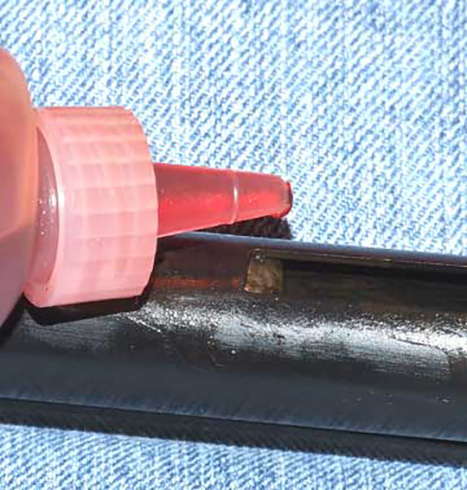
Oiling a multi-pump pneumatic.
This report covers:
- Why this report
- Daisy 880
- Other multi-pumps
- Older front-pump multi-pumps
- Silicone not necessary
- Summary
I’m writing this report lest we forget. Years ago Dennis Quackenbush told me this blog’s most valuable attribute was it recorded airgun history. I think he was right about that. I have written this subject before several times and even had photos like the one above, but today I have something more — a short video!
This video is great because it shows what I have been trying to tell you for almost 20 years. It is so simple and yet, if you don’t understand it and don’t do it, your multi-pumps will cease to function.
Why this report
A couple days ago reader RidgeRunner told us about the Benjamin 130 he brought back from the North Carolina airgun show. As we all read he was having problems getting power from the pistol. But nowhere in his report did he mention oiling the pump head, which is the kiss of death for a multi-pump. That started me wondering.
Ridge told us in the comments that he did oil the pump head, but I wondered how many brand-new airgunners even know that’s necessary. Or why. Hence today’s report.
Multi-pumps work because a pump piston compresses air that then passes into a reservoir to await the shot. A few multi-pumps are good for multiple shots per fill but most are only good for one shot. If the pump head doesn’t seal well, less air is pumped into the reservoir, resulting in less energy.
Oiling helps seal the pump head against the wall of the pump tube. It’s similar to the piston rings in an internal combustion engine, except metal piston rings do not swell in the presence of oil. Leather pump heads do swell, and it’s oil that swells them. But not all multi-pumps have leather pump heads. What about them?
Daisy 880
Daisy’s 880 is a multi-pump pneumatic that has o-rings sealing the pump head. O-rings don’t swell with oil but they do seal the pump head the same way internal combustion engine piston rings do — by sealing the extremely small space between the pump head and the wall of the pump tube. O-rings press against the wall of the pump tube, making the space almost non-existent. Oil keeps them sliding when the pressure is on. So oiling is very important.
I picked the 880 as an example but many inexpensive multi-pumps use o-rings in the same way. Oiling works for all of them.
Other multi-pumps
The Benjamin Variable Pump rifle (used to be the 397/392) that is now apparently obsolete has a synthetic pump head that’s often called a pump cup. Oil seals this in the same way it seals o-rings.
And other multi-pumps use oil in similar ways. In all cases, oiling the pump piston head is a necessary maintenance step.
Older front-pump multi-pumps
Now we come to a different version of the same problem. How do we oil the older front-pump multi-pumps? We’ll look at my Benjamin 700 for this one. Let me show you how that works.
There is no pump linkage slot through which to access the pump head. And there is printing on the pump tube warning you to NOT oil through the air hole! In the manual Benjamin tells you that oil will ruin the valve and rubber plug. I don’t know what rubber plug they mean but there must be one.
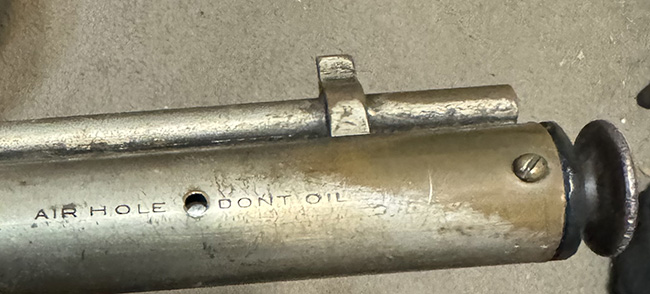
Benjamin tells you not to oil through the air hole.
Notice the small screw at the end of the pump tube. It’s in the photo above. Remove it and the one on the other side of the pump tube and the entire pump rod with pump head can be removed.
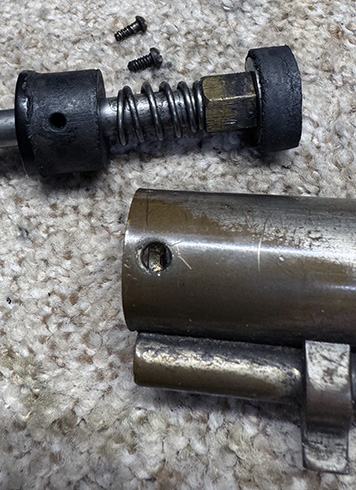
The pump rod is out of the pump tube and the leather pump head is exposed.
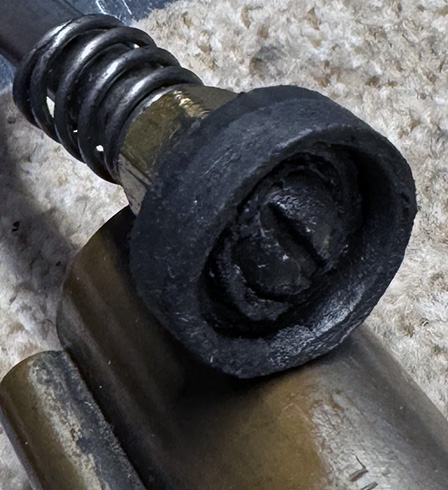
The manual says to remove the pump head by unscrewing the large screw. You can do that or just leave it in place and just rub grease into the head.
The old Benjamin manual says to rub Vaseline grease into the leather pump head.
I found the leather pump head of my 700 was soft and pliable when I examined it so I did not remove it from the pump rod. I just rubbed silicone grease into it — both outside and inside the cup.
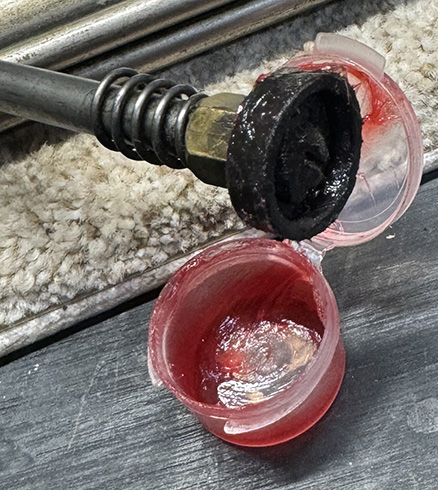
Pump head is greased with silicone grease.
Silicone not necessary
You don’t have to use silicone grease in these guns. Petroleum-based grease like Vaseline is fine. The air pressure never rises high enough to be critical.
Summary
Oiling a multi-pump isn’t difficult. But not oiling it is a recipe for disaster. I know this has been a review for the old-timers but for those new to airguns it is an important bit of knowledge.
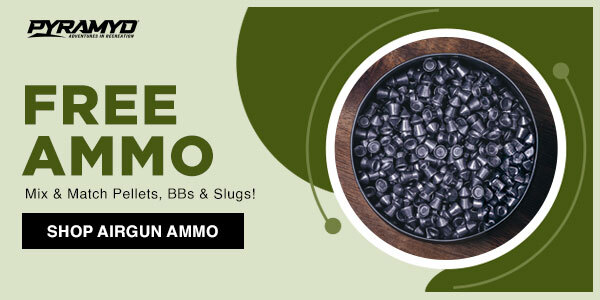
BB,
I love the new short videos!
And even though I have been oiling my multi-pump pneumatics, your video warns me that I may have been a bit too sparing with the oil; I shall have to do some re-lubing tomorrow…thank you! 😉
Blessings to you,
dave
Tom,
This article is good but you forgot to include in the article a small sentence or section on how often they should oil their pumps? Then this article would be great!
Siraniko
Siraniko,
I sort of mentioned frequency in the video but didn’t put it in the text., My bad.
BB
BB,
I have been a bad boy. As you stated, I had not mentioned that I had indeed oiled the leather piston head for the 130.
I am not sure that you are saving it for another blog, but you did not mention about any of the old sproingers that are out there. Almost all of the old sproingers up until the seventies had leather seals. This includes the old bb guns. Both you and I have seen the results of dried out leather seals in these “old gals”. I myself have rebuilt a couple where the old leather seal has “given up the ghost”. It is a real shame because with a little oil the leather seals will last just about forever.
Now, as BB has pointed out, not all of the “old gals” really like to have their leather seals oiled. Those are really few and far between. If you can search around and get your grubby little paws on the old manuals, many of which are now online, it is well worth printing them off and keeping them with that “old gal”. It sure can be nice dancing with that “old gal” every once in a while. 😉
P.S. I have not been blessed to have one of those real old Benjamin straight pumpers come visit at RRHFWA. I am most definitely going to have to keep my eye open for one of them.
I purchased an Air Venturi Dragonfly. 22 cal. pumper for my grandson when they first came ashore a couple of years ago. It gets a thorough wiping down with Balistol after each usage. The “Dragonfly” cocking arm also gets some light grease periodically (not often enough to attract any dirt). It sometimes sits unused for a couple of months at a time. Some of you realize that a mere air rifle can’t quite compete with the most recent video games in a 12 year olds mind. What gives with this? What other maintenance should this modern day pumper be receiving? Thanks, Orv.
Orv,
My grandson, who recently turned 15, bought a Gauntlet when we went to the NC Show at the beginning of this month. I guess it depends on where and who they hang out with as to whether the games hold their interest much.
As for the Dragonfly, I cannot give you a good answer with that as I have not even picked one up. I will have to defer to BB on that one.
What does the manual say?
Orv,
Oil the pump piston head just like the video shows.
BB
Thank you. I’ll look forward to some grandpa/grandson time on how to safely service your rifle. Orv.
Thanks for the well done report. The short videos do help demonstrate how to do some of these things. When I first got the old Daisy No. 25 it was apparently pretty dry and the velocity was significantly low. It improved with each oiling for the first few times. Then leveled off at what is a typical velocity for these BB guns (the best I can tell). So, I suggest keep trying and oiling for a few sessions if one is trying to revive an old dried out seal.
I can just imagine how long it would take a totally dried out leather seal to absorb fresh oil. Good advice. I am going to put a few drops of oil down the transfer ports of all my older breakbarrel springers.
Thank you for this, BB – as the saying goes, a picture or video is worth 1000 words.
As of this writing, the RR Ben Max .22 is still holding 1000 PSI after the silicone oil treatment, which will be repeated at the next shooting session. By the way, FM has brought back to life his old Coleman fuel lantern by oiling the pump cup in it…that old lantern dates back to 1967 so indeed these pumpers, airgun or not, can last a long time with proper maintenance.
FM,
Pooky. I would have thought it was doing better than that. If you would like, I will buy it back off from you. Or maybe even a trade?
RR – after the shooting session ended, PSI was < 1000 so, based on FM’s rememberer hopefully remembering sage advice from BB, pumped it up to 1000 PSI to help keep dirt away from Max’s innards. It is holding that level pressure so far which says the leakage problem is cured or at least minimized.
FM likes the way the lady dances; you trained her well. Sadly, not inclined to let her move at this time. Do appreciate you allowed her to be adopted.
FM,
OK fine. I was under the impression that she had leaked down to 1000 PSI. If you should have a problem with her, please do let me know.
FM
“FM has brought back to life his old Coleman fuel lantern by oiling the pump cup in it.”
Resurrecting the old lantern reminds me of a handy fix for spray bottles that don’t perform as well as they once did. Unscrew the pumper from the plastic bottle and put some Ballistol or petrolatum on the gasket. If it works, great. If not throw it away. I keep a couple of spray heads that work well just in case.
Deck
So that’s why my Ballistol spray head never wears out 😉
Just a little off topic.
A short while back, BB featured one of my blurbs about what I found at the NC Airgun Show this year. Someone, I regretfully do not recall, threw in the comment section about having recently bought an Umarex Komplete. This morning on a whim, I discovered this.
https://www.umarexusa.com/2×12-gram-co2-adapter-for-air-rifles
This thing works well in the Komplete from what I understand. No, I will not be buying and/or testing one of these air rifles in the near/far distant future, but some of you folks out there just might be interested in this thing. Now if I can have an adapter made for a Giffard, I might have to get one of these things.
RidgeRunner
May have been me. The Komplete is a pcp and comes with nitrogen cartridges. Produces over 20 fpe but is so quiet you can shoot it without disturbing either pests or neighbors. Hard Air tested it with CO2 with impressive results delivering far less fpe and far more shots per cartridge. I use both and accuracy is not compromised. It is not advertised as being CO2 capable. I have no idea whether this shortens the life of this rifle but for under $200 and no adaptors or compressors needed it is a winner so far. PA carries it.
Deck
Deck,
It very likely was you. You might want to look at that adapter made by Umarex. It has me a thinking also.
CO² is at a lower pressure than the nitrogen, so it’s probably safe. BUT, personally, I would avoid using Ridgerunner’s suggested adapter with pellgun oil on the two CO² cartridges, as some may do out of habit. I imagine the danger would be that the bit of oxygen that may find it’s way into the system when changing cartridges could ignite the petroleum distillate in the pellgun oil. Use only high temp silicone oil for PCPs. Be safe.
Roamin & RidgeRunner
Thanks for the warning. While this adaptor seems to be fine for the CO2 guns the ad lists, there is the danger someone could use a petroleum lube in the Komplete. I must be diligent about using only silicon on my CO2 cartridges in this rifle. When I switch back to nitrogen this rifle goes back into its intended pcp high velocity mode inviting way too exciting combustion.
Deck
Deck & Roamin,
I agree it’s good practice to use silicon on C02s if you have PCP’s in the house, just to be sure one doesn’t mess up and grab the wrong lube. But, that said, the Komplete is Nitrogen acts as a fire suppressant (I know because I told a person to only use silicon on it and was proven wrong). But for me, I think I would go with only silicon. I think it’s just a matter of time before someone makes a HPA Bottle for the Komplete.
Doc
Doc Holiday,
What you have posted is true.
See my post below for the nitty-gritty of the Explosive FACTS.
shootski
Decksniper,
Being cautious doesn’t always work but Doc Holiday’s post caused me to share a post that may interest you.
shootski
Roamin Greco,
As i shared with Decksniper Doc Holiday is correct in his reply to you two. It caused my to write the post on the EXPLOSIVE topic below.
Hope you enjoy the read!
shootski
B.B., in one picture you say don’t oil the air hole, but in the immediately preceeding text you say don’t oil the oil hole.
Aside from the piston, with what do you lubricate the hinges and the bolt on a multi-pumper? Do you rub moly into the hinges or 3-in-one, or white grease? Do you oil the bolt with pellgun oil because some bolts have an o-ring as well, or something else?
Roamin,
I don’t see a problem in the text about the oil hole. Yes I mention it twice but I don’t see why that is a problem.
Oil all joints, and o-rings. Grease them if you want the lubrication to last. The type of grease shouldn’t matter.
BB
Thanks for the lube advice.
Here is a quote from your text above thebpicture of the air hole: “And there is printing on the pump tube warning you to NOT oil through the oil [air?] hole!”
Roamin,
This time I got it. And fixed it.
Thanks,
BB
No problem. Someone even Siraniko needs a helping hand. ;o)
B.B.,
Yup.
Only a problem if you use 100% Oxygen (or some other reactive gas…why would you or any sane and informed airgunner anyhow?) for fills.
shootski
shootski,
It’s been done.
BB
B.B.,
Sadly…
But NOT by you,
sane airgunners, or me!
shootski
Fills and thrills, I guess. ;o)
Roamin Greco,
Strong NO Thank you for those kind of thrills.
shootski
PS: AND i do like my thrills ;^)
B.B. and Readership,
For B.B.: Thank you for this great Blog topic reminder for the new and not so new to multi pump pneumatics.
For the Readership: Airgun High Pressure Air (HPA) covers a spectrum of gases to include Nitrogen, Carbon Dioxide, Helium, and breathable Air composed of: Nitrogen (around 78%) and Oxygen (around 21%) with trace amounts of other gases like Argon (around 0.9%) and Carbon Dioxide (around 0.04%).
Airgun HPA excludes 100% Oxygen, Hydrogen, Propane, Methane and a number of other reactive gases.
There are at this time only two airgun powerplants that have EXPLOSIVE potential with breathable air providing sufficient percentage of Oxygen to cause an exothermic* reaction due to excessive pressure. Those two powerplants are the Spring Piston and the PCP (Pre Charged Pneumatic) with fill pressures above about 1,900 PSI (131 BAR) with petroleum based lubrication or the other REACTIVE gases and breathable air mixture.
Consider that the Oxygen volume by percent should be 2.5 times that of inflammable gas from a stoichiometric viewpoint there is little to NO chance of an explosion in the rest of the airgun powerplants.
*An exothermic reaction releases heat to its surroundings, causing a temperature increase, while an endothermic reaction absorbs heat from its surroundings, causing a temperature decrease; essentially, “exo” means “out” so an exothermic reaction gives off heat, and “endo” means “in” so an endothermic reaction takes in heat.
The simple point is not to use OXYGEN as a fill gas.
It also is NOT wise to use anything but INERT gases or breathable air to charge a PCP airgun.
PLEASE ask question if this isn’t completely clear.
shootski
Thanks, shootski. So if breathable air has 20% or so Oxygen, would there be any significant oxygen introduced into the valve when the Komplete’s Nitrogen cartridges are exchanged? If there is enough oxygen so introduced, then if there is any combustible material such as petroleum based oil introduced with it, might it combust when the first shot is fired after a cylinder change? For me, I would rather not find out. Rather, I would only use high temp pure silicone oil in a pcp like the Komplete or the Discovery, even if I am filling it with an adapter like the one RidgeRunner suggested.
Roamin Greco,
Best i can tell only Nitrogen and CO2 have been introduced into the system. The valve will be filled with one or the other gas and perhaps a extremely tiny amount of air will get between the fill port and the cylinder as you screw in the new one.
That is why i used the big word stoichiometric since that in basic english means the correct mix/ratio to support an EXPLOSION. There just isn’t enough space to get that ratio even if you emptied the valve allowed it to fill with air and then introduced the CO2 or Nitrogen; a number of things happen that would preclude the explosive mixture since any air introduced is at ambient atmospheric pressure and the gas you add is at many atmospheres of pressure trowing the ratio way off.
Additionally CO2 and Nitrogen are both exothermic reaction extinguishers (fire extinguishers) to boot.
We inflated aircraft tires with Nitrogen for that very reason; to avoid the combined heat and pressure generated particularly by the Trap (landing) aboard an aircraft carrier. CO2 doesn’t work to inflate tires since it is too temperature/pressure unstable.
shootski
BB,
I was recently at a friends house and we got to talking about airguns.
He has a couple of MPP guns. (Crosman 760 & 1377?)
When I asked him about oiling them, he said that he’d always used “air tool oil” in them.
The question that I now have is – do you see any problem with using air tool oil? (He has a compressor & air tools, so it was readily at hand.)
Thank you.
Bill
billj,
air tool oil is probably okay for MPP guns.
Although the following type of product might be a bit of overkill when he gets into PCPs he will be all set.
shootski
You might point him in this direction: https://compressedairusa.com/products/breathing-air-oil-high-pressure-reciprocating-air-compressor-oil-recip-xl-hpba?srsltid=AfmBOooXHrtciME5k8soCtImsOm3rvsX0cgq28BY7SKh2L9UaDyZF7al
billj,
I see no problem with air tool oil.
BB
I once killed the check valve in my Benjamin 347 by using the wrong oil , turned it into a single stroke pneumatic , so long ago I cannot remember what the oil was. After a reseal I only use 50/50 Silicone oil and type F transmission fluid mix, going strong for thirteen hence. My PCP’s only get 100% Silicone oil , the pumpers and C02 guns get the “sauce”.